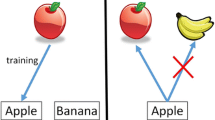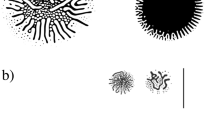Abstract
Some language acquisition studies have used the iterated learning model (ILM). The ILM has been proposed as a hypothetical model of language evolution, and thus the validity of the language acquisition model embedded in the ILM framework remains unclear. In this study, we examine the learning ability for language acquisition using an iterated learning experiment based on ILM in the real world. We introduce the Levenshtein distance for evaluating the similarity of language transmissions made between human participants and between ILM agents. In the real-world experiment, participants extract matching parts, which is a new learning ability that ILM agents do not have. The results show that the language similarity of ILM’s agents remains roughly constant. On the other hand, the language similarity of participants indicates a decreasing trend through transmission generations. We assume that this decreasing trend is caused by the additional process of extracting matching parts. Consequently, we introduce this process to the original ILM to construct an extended model.







Similar content being viewed by others
Explore related subjects
Discover the latest articles, news and stories from top researchers in related subjects.References
Carey S, Bartlett E (1978) Acquiring a single new word. Child Lang Dev 15:17–29
Haryu E (2003) Flexibility of human intelligence: what machine learning suggests. J Jpn Soc Artif Intell 18(5):572–576
Imai M, Gentner D (1994) Children’s theory of word meanings: the role of shape similarity in early acquisition. Cogn Dev 9(1):45–75
Markman EM (1989) Categorization and naming in children: problems of induction. MIT Press, Cambridge
Perfors A, Navarro DJ (2014) Language evolution can be shaped by the structure of the world. Cogn Sci 38(4):775–793
Matoba R, Hayashi Y, Hagiwara S (2017) Applying overextension to first language acquisition under joint attention frame. In: Proceedings of the 22nd international symposium on artificial life and robotics (AROB2017), pp 23–28
Sudo H, Matoba R, Cooper T, Tsukada A (2016) Effect of symmetry bias on linguistic evolution. Artif Life Robot 21(2):207–214
Matoba R, Sudo H, Nakamura M, Tojo S (2015) Application of loose symmetry bias to multiple meaning environment. In: Proceedings of the 7th international conference on advanced cognitive technologies and applications, pp 62–65
Matoba R, Sudo H, Hagiwara S, Tojo S (2013) Evaluation of efficiency of the symmetry bias in grammar acquisition. In: Proceedings of the 18th international symposium on artificial life and robotics, pp 444–447
Matoba R, Nakamura M, Tojo S (2011) Efficiency of the symmetry bias in grammar acquisition. Inf Comput 209(3):536–547
Kirby S (2002) Learning, bottlenecks and the evolution of recursive syntax. In: Briscoe T (ed) Linguistic evolution through language acquisition: formal and computational models. Cambridge (UK), Cambridge, pp 173–204
Chomsky N (1980) Rules and representations. Behav Brain Sci 3(1):1–15
Kirby S (2001) Spontaneous evolution of linguistic structure—an iterated learning model of the emergence of regularity and irregularity. IEEE Trans Evol Comput 5(2):102–110
Zuidema W (2003) How the poverty of the stimulus solves the poverty of the stimulus. In: Becker S, Thrun S, Obermayer K (eds) Advances in neural information processing systems, vol 15. MIT Press, Cambridge, pp 51–58
Brighton H, Smith K, Kirby S (2005) Language as an evolutionary system. Phys Life Rev 2(3):177–226
Kirby S, Cornish H, Smith K (2008) Cumulative cultural evolution in the laboratory: an experimental approach to the origins of structure in human language. Proc Natl Acad Sci 105(31):10681–10686
Hauser M, Chomsky N, Fitch T (2002) The faculty of language: what is it, who has it, and how did it evolve? Science 298(5598):1569–1579
Pinker S, Bloom P (1990) Natural language and natural selection. Behav Brain Sci 13:707–784
Komarova NL, Nowak MA (2001a) Natural selection of the critical period for language acquisition. Proc Biol Sci 268(1472):1189–1196
Komarova NL, Nowak MA (2001b) The evolutionary dynamics of the lexical matrix. Bull Math Biol 63(3):451–484
Zuidema W (2002) Language adaptation helps language acquisition. In: Proceedings of the 7th international conference on the simulation of adaptive behavior, pp 417–418
Verhoef T, Kirby S, Padden C (2011) Cultural emergence of combinatorial structure in an artificial whistled language. In: Proceedings of the 33rd annual conference of the cognitive science society, pp 483–488
Acknowledgements
This work was supported by a Grant-in-Aid for Challenging Exploratory Research 19K22899 and a Grant-in-Aid for Scientific Research (C) 17K02964.
Author information
Authors and Affiliations
Corresponding author
Additional information
Publisher's Note
Springer Nature remains neutral with regard to jurisdictional claims in published maps and institutional affiliations.
About this article
Cite this article
Matoba, R., Yonezawa, T., Hagiwara, S. et al. Extension of iterated learning model based on real-world experiment. Artif Life Robotics 26, 228–234 (2021). https://doi.org/10.1007/s10015-020-00665-9
Received:
Accepted:
Published:
Issue Date:
DOI: https://doi.org/10.1007/s10015-020-00665-9




